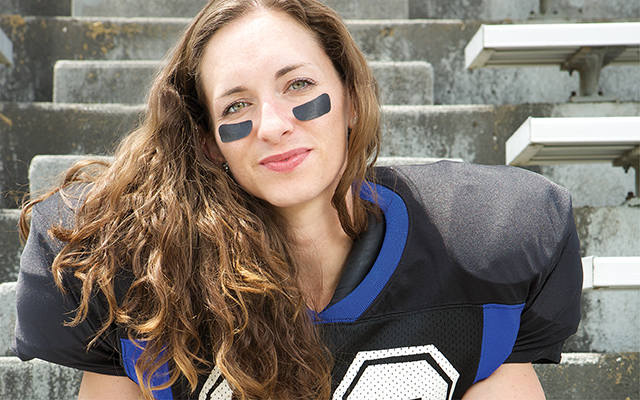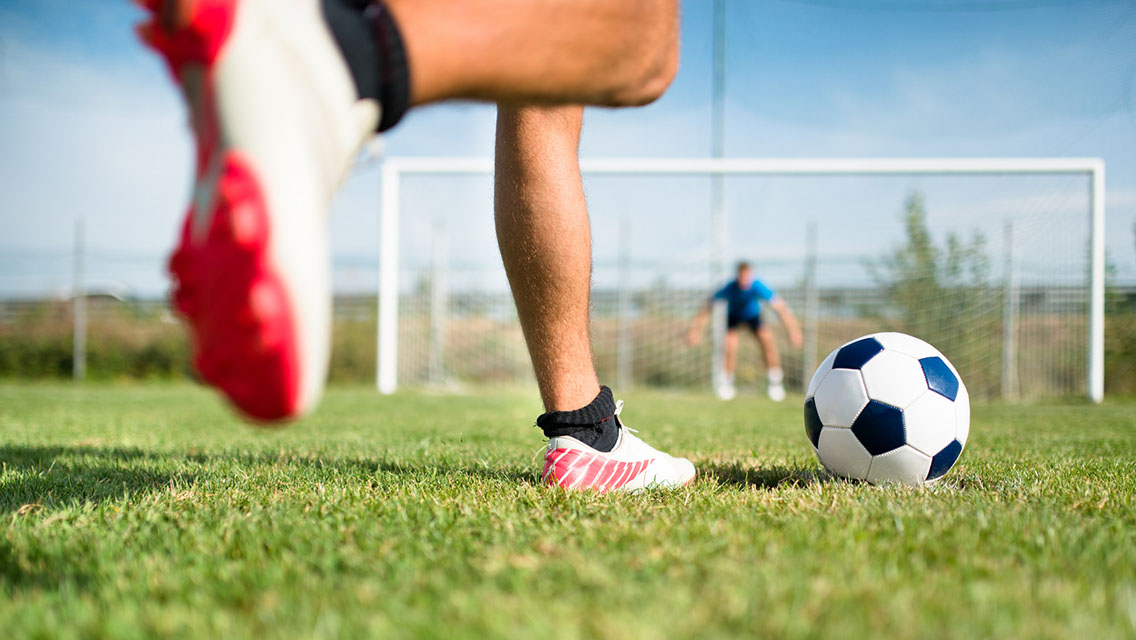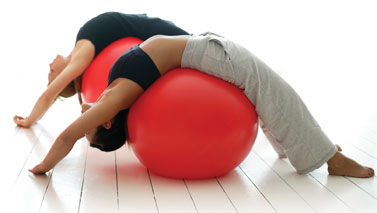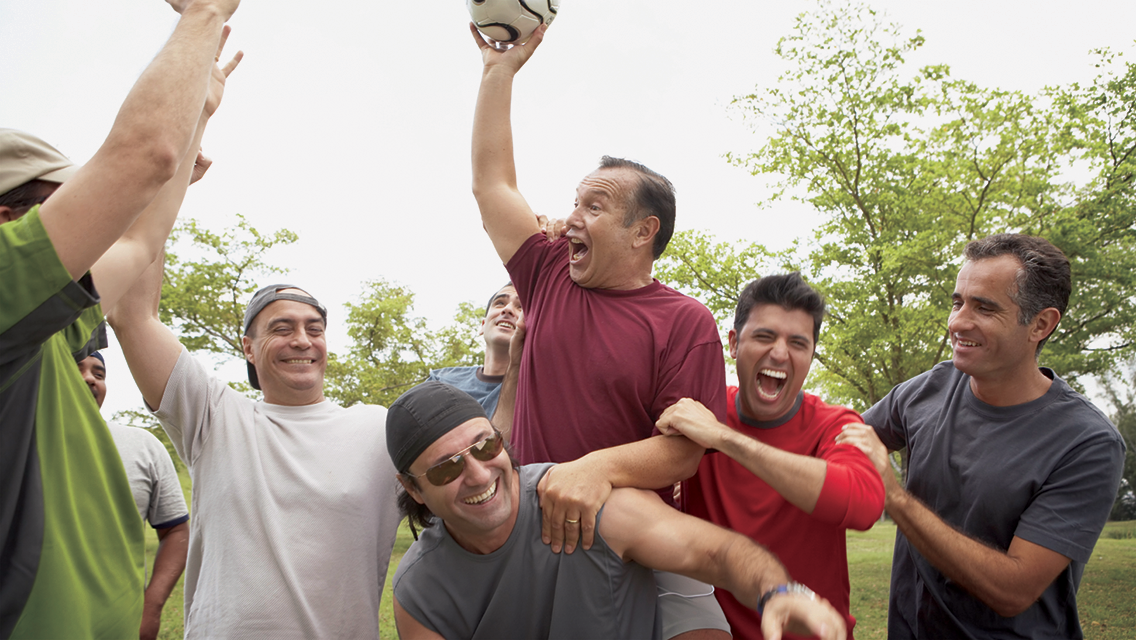Most competitive athletes, no matter their age, have a vivid, personal highlight reel: sprinting across the finish line ahead of the field; eluding ferocious tackles to score the winning touchdown; swishing an impossible three-pointer at the buzzer.
There’s real pleasure in cuing up these glorious, defining memories, of course. Except that, for many of us, those memories didn’t happen yesterday — or even last year. The most remarkable stuff occurred in high school or college, some 10, 20, 30, or even 40 years ago.
Back then you were fueled by a tightly focused determination and drive. You practiced hard, got to the gym early, and stayed late. You trained until you were beyond sore, fueled by fierce competition or the love of your game. You slept well and ate right because you knew it would improve your performance. You had a clear vision of what you intended to achieve.
Today, your fitness focus might be a good deal blurrier. Maybe watching ESPN is your most vigorous activity. Or perhaps you still work out regularly but find that your heart is no longer in it. Perhaps, because of an injury or the passing of the years, your body’s been sidelined from your favorite athletic activities — or it balks at the idea of moving as fast as it used to.
In your chest, though, there still beats the heart of an athlete. You’re a person who once loved activity and challenge — a person who once lived for an athletic goal. You just need to find your way back. You need to find a reason to get fired up.
The good news is that, for most of us, there’s still plenty of time to get strong, play hard, and have fun. It simply requires dedication and an understanding that what you accomplished “back in the day” can both inspire and improve your present situation.
Part of making this forward-looking transition may involve setting new goals and rekindling a new, healthier relationship with your body, one that suits your current priorities, physical condition, and way of life. It may involve letting go of what was, saying goodbye to a former sport of choice, or stripping off an old, outgrown athletic identity that’s begun to feel like a too-tight varsity jacket.
In other words, you don’t have to jettison your golden athletic memories; you just have to loosen your grip on them — and their grip on you. As Marianne Williamson, best-selling author of 15 books, including The Age of Miracles: Embracing the New Midlife, says, “It’s important to start defining ourselves by who we are right now instead of who we aren’t anymore.”
Shaping Up a New Identity
Back in college, Adam Tinkham lived to play soccer, and he was good at it. In fact, he even went pro for a time before he retired because of injuries. For years afterward he drifted from job to job without finding his niche. He’d train for soccer tryouts from time to time, but his fitness routine felt monotonous. Tinkham’s college team had been like a surrogate family, and without this social network, he had trouble meeting people. He also missed the admiration generally accorded star athletes.
Eventually, Tinkham discovered yoga and meditation, which helped him relax and exercise more mindfully. These days, he also cycles for transportation and to stay in shape. And, he’s finally found work he loves: coaching soccer at Chicago’s Team Evanston. “I see my former self in the athletes I coach, but I wouldn’t go back,” says Tinkham, now 43. “It was hard giving up my primary identification as an athlete, but I’m more balanced now — and it feels good.”
Tinkham articulates a realization that many of us would do well to take to heart, notes Williamson: Once we let go of preconceived notions of how things “should be,” we become free to embrace a radically new kind of life — one that’s often more satisfying than we could have imagined.
“It’s sad saying goodbye to youth,” she admits, “but after we’ve moved through that grief — not denied, suppressed, or minimized it — we can joyfully embrace where we are now.”
Perceptions and Priorities
Age eventually becomes an issue for everyone, but it hits many body-oriented athletic types particularly hard. A person who was identified heavily by his or her physical presence and abilities may experience frustration, grief, and even shame over the perceived loss or downgrade of those attributes.
Navigating physical changes can be challenging, Williamson acknowledges, but she argues that getting older brings unanticipated gifts, too. “When you’re young, you might not appreciate what a miracle your body is,” she says. “When you’re older, you realize, ‘Wow, look at where this body has taken me and what it still does for me.’ That understanding will carry you through the next stage of life in a healthy way.”
The first shift involves realigning our relationship with cultural biases that accompany aging — whether we’re 21 or 65 — that are both unfair and unproductive. “If your mental attitude about age is that it’s all a decline, then your body will be in decline,” Williamson explains. “If you see aging as a change — but not a bad one — then your body can physically age in fantastic ways.”
This shift in competitive consciousness will help you become more sensitive to your body’s true needs, desires, instincts, and responses. For instance, Williamson suggests striving to cultivate awareness, curiosity, and patience rather than raw force and conventional competitiveness. “Who made the rule that faster is better?” Williamson asks. Athleticism in later life, she says, is “all about the journey, not the finish line.”
That last truism may sound laughable to serious competitors — because to them, of course, it’s always been about the finish line. If you stay overly attached to race times, rankings, and other rigid results, however, Williamson believes you’ll eventually wind up feeling that you’re fighting a losing battle. You’ll also miss out on some of the better, subtler experiences that a maturing body and life have to offer.
Take 63-year-old Phyllis Dodd, a massage therapist from Cary, N.C. “During the 20 years I was a competitive runner and triathlete, you could set your watch by my training schedule,” she says. “Racing defined me for so long, I couldn’t imagine life after competition.”
In 2001 Dodd was diagnosed with type 1 diabetes, a disease in which the body stops making insulin. “At first I thought my diagnosis was a death sentence. I went through all the stages of grief; I wanted my old life back.” Just a year later, though, she ran a half-marathon — blood-sugar test kits and all — and won her age group.
Regular exercise reduces Dodd’s need for insulin, and she started to genuinely enjoy doing a variety of new activities. Today, competitive racing is no longer important to her.
“I exercise for fun and fitness now,” she says. “I hike with my husband and friends, play coed softball, work out at the gym, run for fun, ride my mountain bike, and play sports with my grandchildren. I used to train to beat the clock and other athletes, but now I train to beat the disease.”
Discover Your Joy
The secret to staying motivated when you’re juggling your athletic, professional, and family identities is first getting your true priorities in order. It also involves finding something that not only makes you feel great, but that you love, says Chris Carmichael, coauthor of 5 Essentials for a Winning Life (Rodale, 2008).
Carmichael speaks from experience. The former Olympic and pro cyclist found himself out of shape and out of touch with his new reality when he stopped competing. It wasn’t until he started focusing on his current priorities and future health, rather than finish lines past, that he was able to transition from athlete to fitness educator, going on to launch Carmichael Training Systems (www.trainright.com).
“I’ve always loved riding my bike. In the old days it was because training meant winning races,” Carmichael says. “Now I ride because I like how training makes me feel — on and off the bike — and how it helps with weight management, stress reduction, mood, and energy levels. I didn’t think about those things as a pro racer, but like many older athletes, I really came to value them in my 40s.”
Reconnecting to your love of sport and reinventing your athletic self takes some mental flexibility. The first step is to honestly assess your body.
Are you seriously out of shape or just feeling a little deconditioned? Have injuries forced you into a long exercise hiatus? Even healed injuries can become obstacles if you’re afraid of reinjury. If you’ve been sidelined, try retooling your training to strengthen weakened muscles or to work around an injured area.
A physical therapist or personal trainer can offer exercises that address your physical situation.
Next, consider the time you can realistically commit to a new exercise regimen. If you’re balancing a full-time career and family, you probably have less time for sports and activity than you did at age 17. That doesn’t mean exercise shouldn’t be a priority; it just might not be the main priority.
“Embrace a big-picture view of fitness,” suggests Carmichael. “Realize how much more focused you’ll be at work and with your loved ones; think of fitness as a way to be active with your kids or grandchildren. When training becomes a hassle — as it does sometimes in a busy life — the big-picture view helps you see the enduring value of sticking with it.”
Once you can see your parameters more clearly, set a specific athletic goal, whether it’s participating in an event or embracing some new sort of active adventure. “Choose a goal that’s important to you, that represents a real challenge, and that’s several months away, so you have time to prepare gradually,” Carmichael advises.
Just trying something new can provide a much-needed shot in the arm — and it’s an injection you may want and need well before you hit a middle-age athletic slump.
Meghan Forgy, a 30-year-old certified personal trainer, competed in track and field in college and played softball for years, but as she reached her mid-20s she began feeling that she was “working out just to work out.” Then she discovered women’s tackle football, which reignited her enthusiasm for sports.
“Football is radically different [from anything I’d done] physically and mentally, which is why it rejuvenated me,” Forgy says. She now weight-trains for power and competition, and she feels inspired to work toward something besides aesthetics. “Now I’ve got big, muscular thighs that give me the strength and explosive speed I need to be a running back.”
While Forgy rediscovered her powerful new athleticism through full-contact competition, other postcollege athletes might find themselves exploring yoga, racquet sports, swimming, climbing, karate, or salsa dancing. The point is, there’s no set formula: It’s all about finding the joy that suits you now.
Take the Initiative
Many athletes struggle when they leave the structure of high school or college athletics, because for years they were told when to be at practice and what to do to perform their best. Now, with no schedule or set routine, some folks lose momentum. Others go into a temporary tailspin — before learning the art of self-motivation.
When she played professional tennis, Alison Gunning had a team of coaches to monitor her diet, performance, and body composition. At age 21, she left the sport because of repeated rotator-cuff injuries. Without her coaches, Gunning’s exercise routine flagged, and within two years her weight ballooned from 118 to 178.
“Until I was on my own, it didn’t click that my coaches knew more about how to feed me than I did,” says Gunning, now a fitness writer in Phoenix. “I didn’t understand the intricacies of how my body works, because someone had always told me what to do.”
Gunning started running, group cycling, playing softball, and reading up on nutrition. She experimented with different combinations of nutritional programs and exercise before ultimately returning to a healthier weight of 135 pounds.
Completing her first half-marathon was an especially meaningful victory. “I kept going because it was my personal goal. Nobody else told me to run; nobody paid me to do it. I trained myself in my spare time, and it was a great feeling.”
You don’t have to go it alone during your life transition, but you do need to take responsibility for your health. Even if you decide to gear up by working with a life coach, health coach, or personal trainer, be sure to retain full ownership of what you need (whether it’s encouragement, accountability, or know-how), and be clear about what you want to learn, do, and experiment with next.
By beefing up your fitness education, you can train more efficiently — important if you’re combining a busy lifestyle with athletic pursuits. Consult exercise and nutrition experts about your goals, health priorities, and concerns. Read up on anatomy, training, and sports nutrition. Consider cardio-fitness testing and heart-rate training. Experiment with interval training, cross-training, yoga, and Pilates to get back in shape. Listen to your body, especially when it needs rest. Keep a fitness journal to track what worked and what didn’t.
Become Your Own Inner Coach
“A lot of us believe the only way to be a good athlete is to get whipped into shape,” says Diane Israel, MA, a Boulder, Colo.–based psychotherapist who specializes in helping ex-athletes apply positive skills to real-life situations. “That belief is not coming from a healthy place. I’ve seen a lot of great athletes perform even better when they train with kindness and balance. As you move into a new phase of your life, you want to come from a place of exercising for fun.”
As you reinvent yourself as the best athlete you can be right now, you can reprogram your internal messages and become your own cheerleader. “Your ideal inner coach is supportive and compassionate,” says Israel. It reminds you that you want to be healthy or get back into shape without beating you up about it.
A former world-class triathlete, Israel herself was once obsessed by negative messages. Driven to excel, she was only 28 when she collapsed from anemia, eating disorders, and chronic fatigue syndrome. “Athletics defined me,” she recalls. “I was ranked No. 3 in the world, but I felt like zero. Nothing I did was good enough.” She chronicled her struggles in the 2008 film Beauty Mark, which examines body image in female athletes (www.beautymarkmovie.com).
Now 53, Israel has remade her athleticism into a joyful, eclectic pursuit that blends running, swimming, yoga, hiking, Pilates, dance, biking, and just about any movement that’s fun. “After beating up my body for so long, I now honor and celebrate being able to move every day,” she says.
As Israel transformed from a self-critical, injured athlete to someone who’s wholly connected — body, mind, and spirit — she identified some important components of a successful, adult approach to fitness and activity: Partner with your body. Invite it to participate and cooperate instead of commanding it to perform. Get out of your rut. Don’t repeat the same exercises. Explore new types of movement. Avoid mechanical or obsessive activities.
Have fun. The bottom line for reinventing your workout is to make it playful, creative, and diverse. Do what makes you happy.
With a little determination, you can quit looking back on who you were “back then” and blaze a path toward a new sort of athleticism. “Even if you’ve been away from athletics for years — even if you’re juggling work, family, and a million responsibilities — you can still tap into your motivation, discipline, focus, and determination,” Israel says. “Leave behind judgments from the past and just do what makes your body feel good. That’s how you free yourself to become the athlete you love being, at any age, at any level.”
Curing the Ex-Athlete Syndrome
Your past athletic training may have taught you discipline, but as your life changes and your relationship with sports changes, you can find yourself in a slump, either pushing too hard or not doing much of anything. Diane Israel, a Boulder, Colo.–based psychotherapist, suggests some ways to patch the disconnection between your old life and the new, soon-to-be-improved you.
The Disconnect: You’re bored by your fitness regimen, even though it’s physically demanding.
The Solution: Seek out some new and exciting forms of exercise.
The Disconnect: You don’t train, but on the weekends you risk injury by exerting yourself well beyond your comfort zone.
The Solution: Commit to two or three regular weekday workouts to start getting in shape. And take it easy, Weekend Warrior — overdoing it only proves you’re not training smart.
The Disconnect: You just can’t seem to commit to a sport or fitness routine.
The Solution: You may be blocked by all-or-nothing thinking. Do you believe you should either compete at an elite level or not at all? Stop taking yourself so seriously, and redefine your goals to include fitness for fun and socialization.|
Visualize Change
You’re ready to switch mindsets, but change is scary. “Take your focus off thinking about the possibility of failing and view your life as an experimental process — that way it’s easier to overcome challenges,” advises Margaret Moore, founder and CEO of Wellcoaches, a training firm for professional wellness coaches who help clients develop personal wellness plans (www.wellcoaches.com). Moore shares her tips for moving forward with positive change:
- Reprioritize. “Your priorities are different at age 55 than when you were 25,” says Moore. “You have to modify your visions and goals as your life evolves.”
- Reframe. Making self-care and fitness a priority is tougher than it looks, because most of us put others’ needs before our own. Realize that staying fit and healthy is the best way to be of service to those you care about most.
- Take baby steps. Make small, gradual, sustainable changes. If you’re trying to lose weight, don’t crash diet. Instead, make just two small scale-backs each day. For example, swap the morning latte for a cup of tea and skip the midnight snack.
How to Make Fitness Fun
Who says workouts have to be drudgery? Explore your options.
- Seek outdoor environments: Hike a new trail, rock climb or go kayaking.
- Unite body, mind and spirit with martial arts. Try tai chi, qigong or aikido.
- Be social. If you like camaraderie, join a league or club.
- Compete again. Find a sport with age-bracket competitions.
- Loosen up with yoga, Pilates or Gyrotonics.
- Merge your to-do list with exercise. Run errands on foot or commute by bike.
- Get creative. Try salsa dancing, Nia, belly-dancing or a hip-hop class.
Athletic Metamorphosis: Quiz Yourself
As you’re working new athletic aspirations into your life framework, ask yourself these questions, suggests Chris Carmichael, CEO of Carmichael Training Systems, which has training centers in Colorado, North Carolina and Arizona.
- Are you a solitary or team athlete? If you crave group dynamics, find like-minded enthusiasts who share your passion for soccer, baseball, volleyball, rugby or ultimate Frisbee. Individualists might try marathon running, cycling, swimming, cross-country skiing or triathlon.
- Can your joints take a beating? If not, go lower impact with swimming, Nordic walking, snowshoeing, water polo, doubles tennis or equipment-assisted sports such as cycling.
- How much time can you give? Golf, triathlons and skiing are difficult to incorporate into a busy lifestyle. Running, swimming, cycling and yoga are easier to slot into a schedule.
- Do you thrive on competition? Look into tennis, racquetball, or pickleball. Or, focus your ambitions on age-group competitions — triathlon, cycling or swimming — so you’re on a level playing field.
This article originally appeared as “Rediscover Your Inner Athlete” in the November 2013 issue of Experience Life.




This Post Has 0 Comments